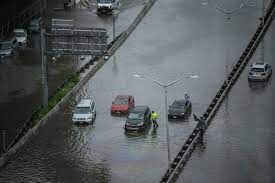New York City Underwater: Heavy Rainfall Causes Severe Flooding, Paralyzes Subways and Airports
A heavy overnight rainfall in NYC caused severe flooding, leading to paralyzed subways and airports. Climate change and inadequate infrastructure were blamed, highlighting the need for improved flood prevention measures.
Heavy overnight rains in the northeastern United States caused severe flooding in New York City on Friday, leading to the partial paralysis of subways and airports. The heavy rainfall resulted in streets being blocked and subway stations flooded, prompting New York Mayor Eric Adams to urge residents to stay at home or shelter in place if they were already at work or school.
LaGuardia airport had to shut down one of its terminals, and images circulating on social media showed passengers wading through knee-high water. The flooding caused extensive damage throughout the city, with cars half-submerged and major roads completely blocked. Shopkeepers in flooded stores were seen trying to protect their merchandise and push water back into the streets.
The New York subway system, one of the world's largest, was also severely affected, with several lines in Brooklyn being shut down. This disrupted the daily commute of millions of New Yorkers and drew criticism from some, like cab driver Ahmed Abdou, who argued that the city should have been better prepared for such recurring weather events.
Rohit Aggarwala, City's Environmental Protection Commissioner, acknowledged that climate change was a major factor contributing to the worsening weather patterns. He stated that the city's infrastructure was not advancing at the same pace as global warming, leaving it ill-equipped to handle these increasingly frequent and severe weather events.
In response to the situation, New York Governor Kathy Hochul declared a state of emergency for the city and its surrounding areas, including Long Island and the Hudson River valley. The National Weather Service issued warnings of continued flooding, estimating rainfall rates of up to two inches per hour and predicting a total accumulation of seven inches for the day.
The service also highlighted the likelihood of flash flooding in urban and poor drainage areas, as well as along small rivers and streams. This recent flooding event evoked memories of the devastating flooding caused by Hurricane Ida in September 2021, which claimed the lives of 13 people and wreaked havoc in Brooklyn and Queens, particularly in basement apartments.
With the renewed threat of flooding, residents in these boroughs were urged to take precautions and consider moving to safer locations if necessary. The subway system, which plays a crucial role in the daily lives of millions of New Yorkers, was significantly impacted by the flooding. Many stations were closed, disrupting the commute of countless individuals who rely on the subway to get to work and school.
Governor Hochul emphasized the importance of restoring subway services promptly, particularly for the sake of students who depend on it for transportation. As climate change continues to pose challenges to infrastructure and urban planning, cities like New York must invest in better flood prevention and response measures to protect their residents and minimize disruptions during extreme weather events.





